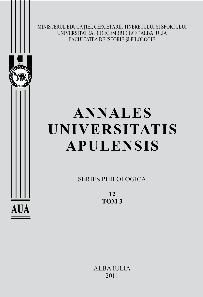The Cognitive Approach to Idiomaticity
The Cognitive Approach to Idiomaticity
Author(s): Cornelia LeuSubject(s): Language and Literature Studies
Published by: Universitatea »1 Decembrie 1918« Alba Iulia
Keywords: Cognitive; Idioms; Image- Schemas; Conceptual Metaphors; Emotions; Perceptions
Summary/Abstract: “Emotion is one of the most central and pervasive aspects of human experience. Normal people experience a wide range of emotions, from the quiet satisfaction of completing a relatively mundane task to the grief at the death of a loved one. ….they (emotions) colour, deepen and enrich human experience” (Ortony, Clore & Collins 1988: 3). According to Weinreich (1969), an idiom is “a complex expression whose meaning cannot be derived from the meanings of its elements”. In Chafe’ opinion (1970) “…many idiomatic expressions are ambiguous, with one interpretation (the literal meaning) deriving from the meanings of the words involved and the other (idiomatic meaning) following the Weinreich definition” (Bobrow & Bell 1973: 343). In Ortony, Clore & Collins’ acceptance, “The study of emotion explains how people’s perceptions of the world- their construals- cause them to experience emotions” (Ortony, Clore & Collins 1988: 12). Thus, it is obvious that emotions can be explained, understood and interpreted from a cognitive approach. “Children are able, from an early age, to abstract across similar kinds of experiences, finding meaningful patterns in the process concepts” (Evans &Green 2006: 46). Concepts, the authors say, “derive from perceptions. The range of perceptual information deriving from the world is integrated into a mental imagery (Evans & Green 2006: 46). The authors use the concept of projected reality, which they define as “a mental representation of reality as construed by the human mind” (Evans & Green 2006: 46). “Experience around us is mediated and structured by the human body. People can only think and talk about what we can perceive and the things we perceive derive from embodied experience. The human mind must bear the imprint of embodied experience”, the authors conclude (Evans & Green 2006: 46). The idea is also rendered by Johnson, who appreciates that “’Contact’, ‘container’, ‘balance’ are meaningful because they derive from and are linked to human pre-conceptual experience: experience of the world mediated and structured by the human body” (Johnson 1990: 168).Our aim is to render some of the most debated conceptual metaphors which are said to organize or to govern idiomatic language of emotions. We aim to reveal some links between affect and taste and some links between affect and the tactile sense. We also intend to debate upon the significance of the orientational up/down within daily life. We also draw the cognitive resorts which lead to the perception of emotions as colours and the perception of moods as weather (Wright 2002: 24). The cognitive basis of these approaches could be found in the explanation that human beings tend to “approach the self to positive objects and avoid negative objects” (Robinson, Mitchell, Kirkeby & Meier 2006: 150). Eating sweet food leads to a pleasant taste and a positive affect (Meier &Robinson 2004:243).
Journal: Annales Universitatis Apulensis. Series Philologica
- Issue Year: 12/2011
- Issue No: 2
- Page Range: 309-330
- Page Count: 21
- Language: English

